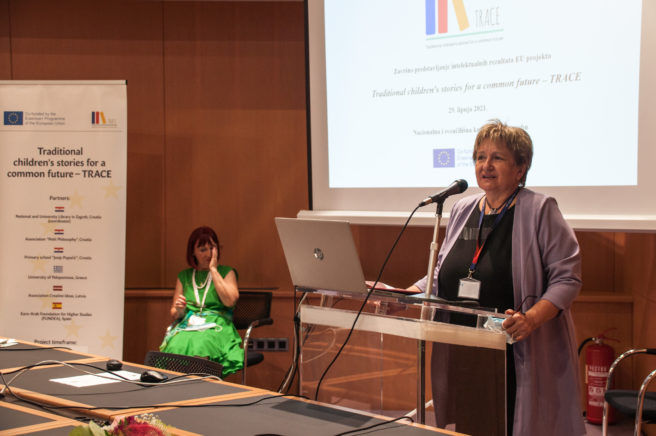
The Multiplier event aiming to share the intellectual outputs of the EU project Traditional Children’s Stories for a Common Future – TRACE was organised in the National and University Library in Zagreb on 29th June 2021. The event brought together teachers, educational workers and librarians working with children between the ages of 6 and 12.
The project’s intellectual outputs are TRACE Educational Package (iO1) and TRACE ePlatform for traditional European children’s stories (iO2).
TRACE Educational Package (iO1) contains research into the use of traditional children’s stories in formal and informal education in the partner countries, the selection of the most representative stories and their subsequent translation into English and the languages of the partner countries, organisation of workshops for children in the targeted age group, evaluation of workshops and the development of suitable learning and teaching materials.
TRACE ePlatform for traditional European children’s stories (iO2) presents each of the selected stories in the original language in parallel with its translation in English and the languages of the partner countries. Apart from making available metadata description in the languages of the partner countries and English for every story in order to enable the wider public to learn more about the stories’ origin, the platform includes a digital version of each story from the selected published edition, and the digital copy of the edition’s cover page, where possible. TRACE ePlatform is a part of the project’s online portal http://www.trace-portal.eu/ and serves as an educational tool for teachers, educational workers and librarians, as well as for the wider public.
The TRACE project was coordinated by the National and University Library in Zagreb. Its project partners were the Association Petit Philosophy (Zadar, Croatia), Primary School Josip Pupačić (Omiš, Croatia), Department of Social and Education Policy at the University of the Peloponnese (Corinth, Greece), Association Creative Ideas (Riga, Latvia) and Euro-Arab Foundation for Higher Studies (Granada, Spain). The project was launched on 1st September 2018 and will last until the end of the July 2021.
The TRACE project targets are teachers, educational workers and librarians working with children between the ages of 6 and 12. The aim is to get them acquainted with traditional children’s stories from the partner countries, and thus also with these countries’ cultures. Apart from the translation of the finest works of children’s literature into English and the languages of the partner countries, the project activities also included workshops presenting creative and innovative methods of using traditional children’s stories, as a valuable part of European cultural heritage, to encourage reading, critical thinking and research of one’s own culture among children in the targeted age group.
21 traditional children’s stories have been selected as part of the TRACE project, and translated into English language and into the languages of the partner countries in order to present to a wider audience the cultural heritage of Croatia, Greece, Latvia and Spain, as well as to help these countries’ young generations to exchange and thus keep alive that valuable legacy. The selection process included eminent professionals in the field of education and information and communication sciences in each of the four countries.
Selected stories, by country:
Croatia:
Froggy Girl
The Black Ram
The Story of the Plitvice Lakes
Manda’s Well
Red Rocks
Don’t Bump into a Tree or Hit the Stone
Greece:
Theseus and the Minotaur
Icarus & Daedalus Wings
The Man, the Boy and the Donkey
Latvia:
The Golden Egg
The Little Bread Bun
The Old Man’s Mitten
Wild Animals and the Dough Box Maker
The Bee is Punished for Lying
The Fly is Granted the Freedom of Choice
The Grateful Creatures
The Star Tram
Spain:
The Monk and the Weasel
The Traveller and the Goldsmith
The Caliph, the Shepherd and Happiness
How to Teach an Elephant to Speak